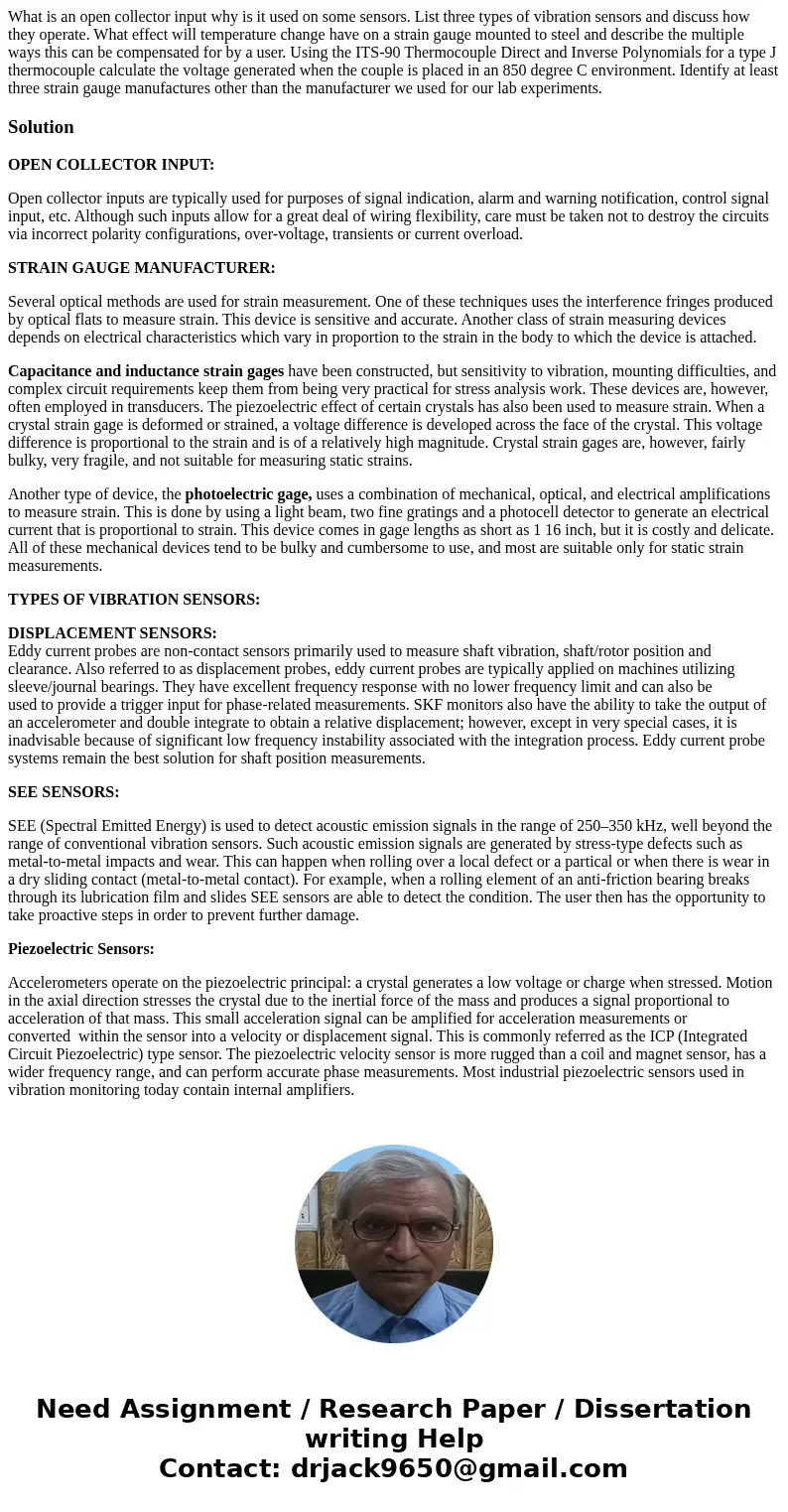What is an open collector input why is it used on some senso
Solution
OPEN COLLECTOR INPUT:
Open collector inputs are typically used for purposes of signal indication, alarm and warning notification, control signal input, etc. Although such inputs allow for a great deal of wiring flexibility, care must be taken not to destroy the circuits via incorrect polarity configurations, over-voltage, transients or current overload.
STRAIN GAUGE MANUFACTURER:
Several optical methods are used for strain measurement. One of these techniques uses the interference fringes produced by optical flats to measure strain. This device is sensitive and accurate. Another class of strain measuring devices depends on electrical characteristics which vary in proportion to the strain in the body to which the device is attached.
Capacitance and inductance strain gages have been constructed, but sensitivity to vibration, mounting difficulties, and complex circuit requirements keep them from being very practical for stress analysis work. These devices are, however, often employed in transducers. The piezoelectric effect of certain crystals has also been used to measure strain. When a crystal strain gage is deformed or strained, a voltage difference is developed across the face of the crystal. This voltage difference is proportional to the strain and is of a relatively high magnitude. Crystal strain gages are, however, fairly bulky, very fragile, and not suitable for measuring static strains.
Another type of device, the photoelectric gage, uses a combination of mechanical, optical, and electrical amplifications to measure strain. This is done by using a light beam, two fine gratings and a photocell detector to generate an electrical current that is proportional to strain. This device comes in gage lengths as short as 1 16 inch, but it is costly and delicate. All of these mechanical devices tend to be bulky and cumbersome to use, and most are suitable only for static strain measurements.
TYPES OF VIBRATION SENSORS:
DISPLACEMENT SENSORS:
Eddy current probes are non-contact sensors primarily used to measure shaft vibration, shaft/rotor position and
clearance. Also referred to as displacement probes, eddy current probes are typically applied on machines utilizing
sleeve/journal bearings. They have excellent frequency response with no lower frequency limit and can also be
used to provide a trigger input for phase-related measurements. SKF monitors also have the ability to take the output of an accelerometer and double integrate to obtain a relative displacement; however, except in very special cases, it is inadvisable because of significant low frequency instability associated with the integration process. Eddy current probe systems remain the best solution for shaft position measurements.
SEE SENSORS:
SEE (Spectral Emitted Energy) is used to detect acoustic emission signals in the range of 250–350 kHz, well beyond the range of conventional vibration sensors. Such acoustic emission signals are generated by stress-type defects such as metal-to-metal impacts and wear. This can happen when rolling over a local defect or a partical or when there is wear in a dry sliding contact (metal-to-metal contact). For example, when a rolling element of an anti-friction bearing breaks through its lubrication film and slides SEE sensors are able to detect the condition. The user then has the opportunity to take proactive steps in order to prevent further damage.
Piezoelectric Sensors:
Accelerometers operate on the piezoelectric principal: a crystal generates a low voltage or charge when stressed. Motion in the axial direction stresses the crystal due to the inertial force of the mass and produces a signal proportional to acceleration of that mass. This small acceleration signal can be amplified for acceleration measurements or converted within the sensor into a velocity or displacement signal. This is commonly referred as the ICP (Integrated Circuit Piezoelectric) type sensor. The piezoelectric velocity sensor is more rugged than a coil and magnet sensor, has a wider frequency range, and can perform accurate phase measurements. Most industrial piezoelectric sensors used in vibration monitoring today contain internal amplifiers.
WHAT EFFECT WILL TEMPERATURE CHANGE ON STRAIN GAUGE MOUNTED ON STEEL:
The resistance of the strain gauge to change only in response to applied strain. However, strain gauge material, as well as the specimen material to which the gauge is applied, will also respond to changes in temperature. Strain gauge manufacturers attempt to minimize sensitivity to temperature by processing the gauge material to compensate for the thermal expansion of the specimen material for which the gauge is intended. While compensated gauges reduce the thermal sensitivity, they do not totally remove it.


 Homework Sourse
Homework Sourse